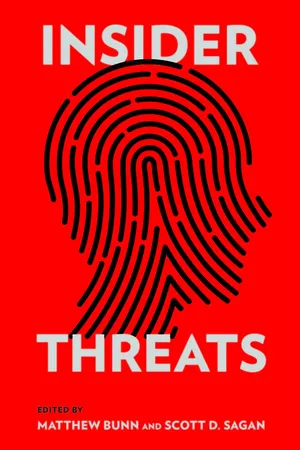
- 216 pages
- English
- ePUB (mobile friendly)
- Available on iOS & Android
Insider Threats
About this book
"This compendium of research on insider threats is essential reading for all personnel with accountabilities for security; it shows graphically the extent and persistence of the threat that all organizations face and against which they must take preventive measures."
— Roger Howsley, Executive Director, World Institute for Nuclear Security
High-security organizations around the world face devastating threats from insiders—trusted employees with access to sensitive information, facilities, and materials. From Edward Snowden to the Fort Hood shooter to the theft of nuclear materials, the threat from insiders is on the front page and at the top of the policy agenda. Insider Threats offers detailed case studies of insider disasters across a range of different types of institutions, from biological research laboratories, to nuclear power plants, to the U.S. Army. Matthew Bunn and Scott D. Sagan outline cognitive and organizational biases that lead organizations to downplay the insider threat, and they synthesize "worst practices" from these past mistakes, offering lessons that will be valuable for any organization with high security and a lot to lose.
Insider threats pose dangers to anyone who handles information that is secret or proprietary, material that is highly valuable or hazardous, people who must be protected, or facilities that might be sabotaged. This is the first book to offer in-depth case studies across a range of industries and contexts, allowing entities such as nuclear facilities and casinos to learn from each other. It also offers an unprecedented analysis of terrorist thinking about using insiders to get fissile material or sabotage nuclear facilities.
Contributors: Matthew Bunn, Harvard University; Andreas Hoelstad Dæhli, Oslo; Kathryn M. Glynn, IBM Global Business Services;
Thomas Hegghammer, Norwegian Defence Research Establishment, Oslo; Austin Long, Columbia University; Scott D. Sagan, Stanford University; Ronald Schouten, Massachusetts General Hospital and Harvard Medical School; Jessica Stern, Harvard University; Amy B. Zegart, Stanford University
Frequently asked questions
- Essential is ideal for learners and professionals who enjoy exploring a wide range of subjects. Access the Essential Library with 800,000+ trusted titles and best-sellers across business, personal growth, and the humanities. Includes unlimited reading time and Standard Read Aloud voice.
- Complete: Perfect for advanced learners and researchers needing full, unrestricted access. Unlock 1.4M+ books across hundreds of subjects, including academic and specialized titles. The Complete Plan also includes advanced features like Premium Read Aloud and Research Assistant.
Please note we cannot support devices running on iOS 13 and Android 7 or earlier. Learn more about using the app.
Information
CHAPTER 1
Insiders and Outsiders
Terrorist Views on Nuclear Targets and Infi ltration
JIHADI GROUPS
- “Al-Qaida issues statement on the strike against electricity in America” (Montada, August 18, 2003). Post relaying the statement by the “Abu Hafs al-Masri Brigades” (falsely) claiming responsibility for the electricity outage in the U.S. Northeast and Canada. The statement lists fifteen “benefits” of the attack, the eighth of which was “the closing of nine nuclear reactors, which has never happened before and constitutes a powerful economic blow.”
- “Can you present al-Qaida with a plan to hit the Americans and the Brits in their own homes?” (Shamikh, December 1, 2007). Short, somewhat cryptic message that reads: “Can you present al-Qaida with a plan to hit the America and Britain in their own homes?...
Table of contents
- List of Contributors
- Acknowledgments
- Introduction: Inside the Insider Threat
- 1. Insiders and Outsiders: A Survey of Terrorist Threats to Nuclear Facilities
- 2. The Fort Hood Terrorist Attack: An Organizational Postmortem of Army and FBI Deficiencies
- 3. Lessons from the Anthrax Letters
- 4. Green-on-Blue Violence: A First Look at Lessons from the Insider Threat in Afghanistan
- 5. Preventing Insider Theft: Lessons from the Casino and Pharmaceutical Industries
- 6. A Worst Practices Guide to Insider Threats
- Index